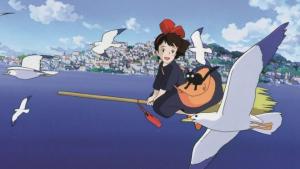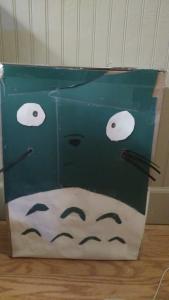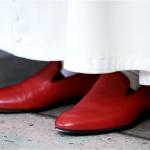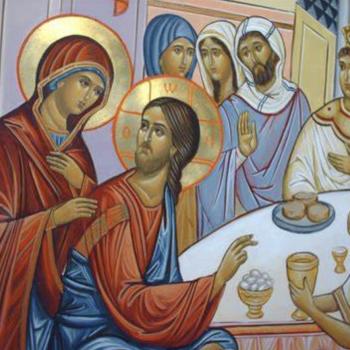If you happen to visit our house sometime and find yourself invited down to our basement, you will notice two things: 1. board games, and 2. this large figure made out of a cardboard box.
He used to have ears, but they fell off.
These things happen.
For those of you not in the know, this is a cardboard sculpture of Totoro. Totoro (or, more properly, My Neighbor Totoro) is a film by the Japanese animation studio, Studio Ghibli. If you haven’t seen a Studio Ghibli film, you are missing out. Their films are favorites in our house. They are brilliant, whimsical, and emotional. They can also be incredibly bizarre, weird, and frightening – sometimes a bit too much for the youngest members of the household.
The most gentle of the Ghibli films is a charming movie called Kiki’s Delivery Service. The protagonist, Kiki, is a young witch striking out on her own. In this fictional world, witchcraft is something a girl inherits from her mother, like brown eyes or red hair. It is a traditional profession, and one of its traditions is witch children striking out at the  age of twelve to try their skills and gain independence as a professional witch. Kiki is beyond excited to spread her metaphorical wings and strike out on her own, but there is a problem: her mother hasn’t had the time to teach her how to make potions, and she is not a fortune-teller. Her only real skill is flying a broom, and even that skill is somewhat shaky.
age of twelve to try their skills and gain independence as a professional witch. Kiki is beyond excited to spread her metaphorical wings and strike out on her own, but there is a problem: her mother hasn’t had the time to teach her how to make potions, and she is not a fortune-teller. Her only real skill is flying a broom, and even that skill is somewhat shaky.
Despite her parents’ trepidation, Kiki sets out to find her independence. She settles in a seaside town, where she decides to use her one witchy skill to open a delivery business. She is lucky to find a handful of adults who recognize her abilities and value her, and she in turn sees these adults as friends and companions. She values them.
But there is a problem – Kiki is not able to make any kind of connection with her peers. Afflicted with pre-teen anxiety about boys, she isn’t able to connect with a boy (Tombo) who finds her fascinating, and who pursues her with touching devotion. What’s more, she finds that her world has become more akin to the world of adults than the world of children. As a witch, she has abilities that the other kids have never seen before. She has to work and support herself. She recognizes that the other kids she meets see her as something “other,” and that this causes them to disengage from her. As Kiki becomes more and more lonely, she begins to see herself as “other.”
Eventually, Kiki’s unhappiness and sense of alienation lead to the unthinkable: she begins to lose her magic. Unable to fly, and unable to maintain her delivery service, she cries, “If I’ve lost my magic, I’ve lost everything!” She is desperately unhappy, but once again the adults in her life come to the rescue. An artist friend invites her to come and stay with her for a few days in her cabin in the woods. There, Kiki is confronted with a painting of herself. As she gazes as the Chagall-esque picture, she is amazed to discover that this is how her friend sees her. It’s a moment of poignant contrast between the beauty of the painting and the way Kiki feels about herself.
This scene sets the stage for a moving conversation between Kiki and the artist. The artist tells Kiki about a time when she too lost her abilities. She had been driven to paint, and loved to paint, but one day all desire to paint seemed to go away. She was dissatisfied with herself and with her work, and she wondered if she’d ever paint again. She explains that she had to discover within herself the reasons why she wanted to paint. She reminds Kiki that painting and magic are works of the spirit, and that the ability to make art or perform magic comes from the heart. She assures Kiki that her abilities will come back – she just has to discover her own reasons for wanting to do magic at all.
Matt has already written about the difference between external and internal reasons for faith. Kiki echoes those themes. We grow up Catholic, or we convert, and for a while we are more than content to be directed to by the Church. We want the security of an external source that can guide us and help us see our way through life’s ambiguities. We mistrust ourselves, and tie our spiritual lives to the workings of an external community that frequently operates independently of us. We see this as a feature, not a bug.
There can come a moment, however, when we find ourselves losing our ability to believe. Maybe our local community has failed us. Maybe the Church as a whole has failed us. Maybe we just aren’t sure about what once seemed so certain. Referring to something external no longer satisfies us. Referring to something external no longer seems wise.
This is the moment when we start to look within and discover something astonishing: we have a spirit. I have a spirit. When my children were small, I used to tell them that Jesus was in their hearts. It’s remarkable, as an adult, to discover that this is true.
Like Kiki, we look to our spirit for our reasons for belief, and the spirit’s reasons for belief turn out to be very different from reasons that come from without. Discovering them is not entirely unlike the experience of an awkward twelve-year-old witch looking at her portrait, as painted by a friend.
Kiki eventually regains her abilities, and discovers that her reasons for wanting to do magic have a lot to do with love and with friendship. Her recovery of her magical ability is at first unpredictable. She has to find new tools for channeling her magic. She has to find new ways of doing what had previously come naturally, but she gets there.
And so will we.
Maren Grossman is an assistant editor at Sick Pilgrim. She holds an M.A. in philosophy from Catholic University and currently lives in Pennsylvania with her family.













